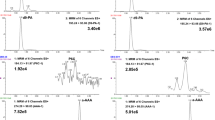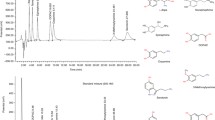Abstract
Background Menkes disease is an X-linked recessive neurodevelopmental disorder resulting from mutation in a copper-transporting ATPase gene. Menkes disease can be detected by relatively high concentrations of dopamine (DA) and its metabolites compared to norepinephrine (NE) and its metabolites, presumably because dopamine-beta-hydroxylase (DBH) requires copper as a co-factor. The relative diagnostic efficiencies of levels of catechol analytes, alone or in combination, in neonates at genetic risk of Menkes disease have been unknown. Methods Plasma from 44 at-risk neonates less than 30 days old were assayed for DA, NE, and other catechols. Of the 44, 19 were diagnosed subsequently with Menkes disease, and 25 were unaffected. Results Compared to unaffected at-risk infants, those with Menkes disease had high plasma DA (P < 10−6) and low NE (P < 10−6) levels. Considered alone, neither DA nor NE levels had perfect sensitivity, whereas the ratio of DA:NE was higher in all affected than in all unaffected subjects (P = 2 × 10−8). Analogously, levels of the DA metabolite, dihydroxyphenylacetic acid (DOPAC), and the NE metabolite, dihydroxyphenylglycol (DHPG), were imperfectly sensitive, whereas the DOPAC:DHPG ratio was higher in all affected than in all unaffected subjects (P = 2 × 10−4). Plasma dihydroxyphenylalanine (DOPA) and the ratio of epinephrine (EPI):NE levels were higher in affected than in unaffected neonates (P = 0.0015; P = 0.013). Conclusions Plasma DA:NE and DOPAC:DHPG ratios are remarkably sensitive and specific for diagnosing Menkes disease in at-risk newborns. Affected newborns also have elevated DOPA and EPI:NE ratios, which decreased DBH activity alone cannot explain.




Similar content being viewed by others
Abbreviations
- DA:
-
Dopamine
- DBH:
-
Dopamine-β-hydroxylase
- DHPG:
-
Dihydroxyphenylglycol
- DOPA:
-
l-3,4-Dihydroxyphenylalanine
- DOPAC:
-
Dihydroxyphenylacetic acid
- NE:
-
Norepinephrine
References
Kaler SG, Holmes CS, Goldstein DS et al (2008) Neonatal diagnosis and treatment of Menkes disease. N Eng J Med 358:605–614. doi:10.1056/NEJMoa070613
Kaler SG, Goldstein DS, Holmes C et al (1993) Plasma and cerebrospinal fluid neurochemical pattern in Menkes’ disease. Ann Neurol 33:171–175. doi:10.1002/ana.410330206
Hoeldtke RD, Cavanaugh ST, Hughes JD et al (1988) Catecholamine metabolism in kinky hair disease. Pediatr Neurol 4:23–26. doi:10.1016/0887-8994(88)90020-3
Holmes C, Eisenhofer G, Goldstein DS (1994) Improved assay for plasma dihydroxyphenylacetic acid and other catechols using high-performance liquid chromatography with electrochemical detection. J Chromatogr B Biomed Appl 653:131–138. doi:10.1016/0378-4347(93)E0430-X
Gordon SL, Quinsey NS, Dunkley PR et al (2008) Tyrosine hydroxylase activity is regulated by two distinct dopamine-binding sites. J Neurochem 106:1614–1623
Ames MM, Lerner P, Lovenberg W (1978) Tyrosine hydroxylase: activation by protein phosphorylation and end product inhibition. J Biol Chem 253:27–31
Carlsson A, Kehr W, Lindqvist M (1976) The role of intraneuronal amine levels in the feedback control of dopamine, noradrenaline and 5-hydroxytryptamine synthesis in rat brain. J Neural Transm 39:1–19. doi:10.1007/BF01248762
Goldstein DS, Udelsman R, Eisenhofer G et al (1987) Neuronal source of plasma dihydroxyphenylalanine. J Clin Endocrinol Metab 64:856–861
Kvetnansky R, Armando I, Weise VK et al (1992) Plasma dopa responses during stress: dependence on sympathoneural activity and tyrosine hydroxylation. J Pharmacol Exp Ther 261:899–909
Thompson JM, O’callaghan CJ, Kingwell BA et al (1995) Total norepinephrine spillover, muscle sympathetic nerve activity and heart-rate spectral analysis in a patient with dopamine beta-hydroxylase deficiency. J Auton Nerv Syst 55:198–206. doi:10.1016/0165-1838(95)00048-3
Tornkvist A, Sjoberg PJ, Markides KE et al (2004) Analysis of catecholamines and related substances using porous graphitic carbon as separation media in liquid chromatography-tandem mass spectrometry. J Chromatogr B Analyt Technol Biomed Life Sci 801:323–329. doi:10.1016/j.jchromb.2003.11.036
Carrera V, Sabater E, Vilanova E et al (2007) A simple and rapid HPLC-MS method for the simultaneous determination of epinephrine, norepinephrine, dopamine and 5-hydroxytryptamine: application to the secretion of bovine chromaffin cell cultures. J Chromatogr B Analyt Technol Biomed Life Sci 847:88–94. doi:10.1016/j.jchromb.2006.09.032
Vuorensola K, Siren H, Karjalainen U (2003) Determination of dopamine and methoxycatecholamines in patient urine by liquid chromatography with electrochemical detection and by capillary electrophoresis coupled with spectrophotometry and mass spectrometry. J Chromatogr B Analyt Technol Biomed Life Sci 788:277–289. doi:10.1016/S1570-0232(02)01037-1
Hasegawa T, Wada K, Hiyama E et al (2006) Pretreatment and one-shot separating analysis of whole catecholamine metabolites in plasma by using LC/MS. Anal Bioanal Chem 385:814–820. doi:10.1007/s00216-006-0459-5
Acknowledgments
The research reported here was supported by the intramural programs of the NINDS and NICHD.
Author information
Authors and Affiliations
Corresponding author
Rights and permissions
About this article
Cite this article
Goldstein, D.S., Holmes, C.S. & Kaler, S.G. Relative Efficiencies of Plasma Catechol Levels and Ratios for Neonatal Diagnosis of Menkes Disease. Neurochem Res 34, 1464–1468 (2009). https://doi.org/10.1007/s11064-009-9933-8
Received:
Accepted:
Published:
Issue Date:
DOI: https://doi.org/10.1007/s11064-009-9933-8




